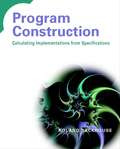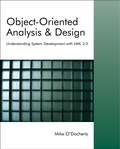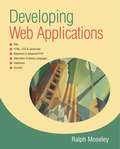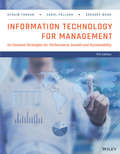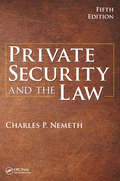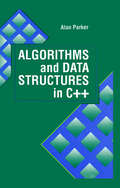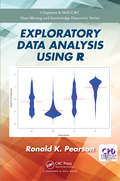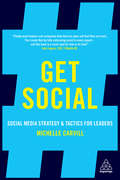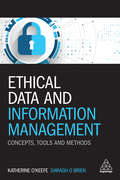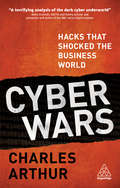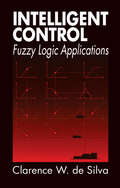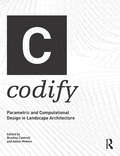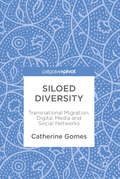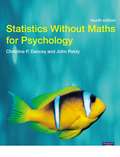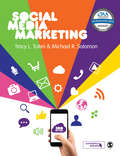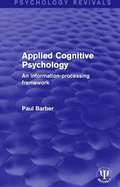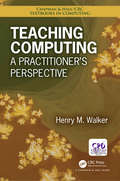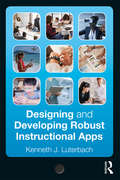- Table View
- List View
Program Construction: Calculating Implementations from Specifications
by Roland BackhouseUnique approach tackles what most books don't-why maths and logic are fundamental tools for a programmer This comprehensive guide is a balanced combination of mathematical theory and the practice of programming Straightforward presentation of construction principles inlcuding: assignment axiom, sequential composition, case analysis, use of invariants and bound functions Includes a wide range of entertaining and challenging examples and exercises
Object-Oriented Analysis and Design: Understanding System Development with UML 2.0
by Mike O'DochertyCovering the breadth of a large topic, this book provides a thorough grounding in object-oriented concepts, the software development process, UML and multi-tier technologies. After covering some basic ground work underpinning OO software projects, the book follows the steps of a typical development project (Requirements Capture - Design - Specification & Test), showing how an abstract problem is taken through to a concrete solution. The book is programming language agnostic - so code is kept to a minimum to avoid detail and deviation into implementation minutiae. A single case study running through the text provides a realistic example showing development from an initial proposal through to a finished system. Key artifacts such as the requirements document and detailed designs are included. For each aspect of the case study, there is an exercise for the reader to produce similar documents for a different system.
Developing Web Applications
by Ralph MoseleyBuilding applications for the Internet is a complex and fast-moving field which utilizes a variety of continually evolving technologies. Whether your perspective is from the client or server side, there are many languages to master – X(HTML), JavaScript, PHP, XML and CSS to name but a few. These languages have to work together cleanly, logically and in harmony with the systems they run on, and be compatible with any browsers with which they interact. Developing Web Applications presents script writing and good programming practice but also allows students to see how the individual technologies fit together. It includes recent technical developments to provide a practical and modern introduction to building web applications. Assuming no prior programming experience, this concise, accessible book ensures that essential concepts on the client side are quickly grasped, and goes on to examine the server environment and available languages, including discussion of dynamic, modern scripting languages such as PHP. Network and security issues are also discussed. The aim of this book is to deliver exactly what is needed to start producing working applications as soon as possible – and have fun along the way. Ideal for course use or self-study, this book includes practical suggestions for mini-projects which encourage the reader to explore his or her own imaginative solutions, as well as more theoretical end-of-chapter questions. It can also easily be used as a reference work as each section is self-contained, amplifying the key aspects of its particular topic. Most software covered is freely available in the public domain and no particular development environments are required. It is a direct, contemporary and extremely useful resource for anyone interested in learning how to program applications for the World Wide Web.
Information Technology for Management, Enhanced eText: On-Demand Strategies for Performance, Growth and Sustainability
by Efraim Turban Carol Pollard Gregory WoodInformation technology is ever-changing, and that means that those who are working, or planning to work, in the field of IT management must always be learning. In the new edition of the acclaimed Information Technology for Management, the latest developments in the real world of IT management are covered in detail thanks to the input of IT managers and practitioners from top companies and organizations from around the world. Focusing on both the underlying technological developments in the field and the important business drivers performance, growth and sustainability—the text will help students explore and understand the vital importance of IT’s role vis-a-vis the three components of business performance improvement: people, processes, and technology. The book also features a blended learning approach that employs content that is presented visually, textually, and interactively to enable students with different learning styles to easily understand and retain information. Coverage of next technologies is up to date, including cutting-edged technologies, and case studies help to reinforce material in a way that few texts can.
Private Security and the Law, 5th Edition
by Charles P. NemethPrivate Security and the Law, Fifth Edition, is a singular resource that provides the most comprehensive analysis of practices in the security industry with respect to law, regulation, licensure, and constitutional questions of case and statutory authority. The book begins with a historical background of the security industry, laws and regulations that walks step-by-step through the analysis of the development of case law over the years as it applies to situations commonly faced by security practitioners. It describes the legal requirements faced by security firms and emphasizes the liability problems common to security operations, including negligence and tortious liability, civil actions frequently litigated, and strategies to avoid legal actions that affect business efficiency. In addition, chapters examine the constitutional and due-process dimensions of private security both domestically and internationally, including recent cases and trends that are likely to intensify in the future. Updated coverage new to this edition includes developments in statutory authority, changes to state and federal processes of oversight and licensure, and special analysis of public-private cooperative relationships in law enforcement. Key features include: Up to date case law analysis provides cutting edge legal treatment of evolving standards Complicated material is presented in a straight-forward, readable style perfect for the student or security professional Includes over 200 tables and figures that illustrate concepts and present critical comparative data on statutes and regulations National scope provides crucial parameters to security practitioners throughout the U.S. Numerous case studies, case readings, and case examples provide real-world examples of security law and litigation in practice Private Security and the Law, Fifth Edition is an authoritative, scholarly treatise that serves as a valuable reference for professionals and an introduction for students in security management and criminal justice programs regarding the legal and ethical standards that shape the industry.
Algorithms and Data Structures in C++
by Alan ParkerAlgorithms and Data Structures in C++ introduces modern issues in the theory of algorithms, emphasizing complexity, graphs, parallel processing, and visualization. To accomplish this, the book uses an appropriate subset of frequently utilized and representative algorithms and applications in order to demonstrate the unique and modern aspects of the C++ programming language. What makes this book so valuable is that many complete C++ programs have been compiled and executed on multiple platforms. Each program presented is a stand-alone functional program. A number of applications that exercise significant features of C++, including templates and polymorphisms, is included. The book is a perfect text for computer science and engineering students in traditional algorithms or data structures courses. It will also benefit professionals in all fields of computer science and engineering.
Exploratory Data Analysis Using R (Chapman and Hall/CRC Data Mining and Knowledge Discovery Series)
by Ronald K. PearsonExploratory Data Analysis Using R provides a classroom-tested introduction to exploratory data analysis (EDA) and introduces the range of "interesting" – good, bad, and ugly – features that can be found in data, and why it is important to find them. It also introduces the mechanics of using R to explore and explain data. The book begins with a detailed overview of data, exploratory analysis, and R, as well as graphics in R. It then explores working with external data, linear regression models, and crafting data stories. The second part of the book focuses on developing R programs, including good programming practices and examples, working with text data, and general predictive models. The book ends with a chapter on "keeping it all together" that includes managing the R installation, managing files, documenting, and an introduction to reproducible computing. The book is designed for both advanced undergraduate, entry-level graduate students, and working professionals with little to no prior exposure to data analysis, modeling, statistics, or programming. it keeps the treatment relatively non-mathematical, even though data analysis is an inherently mathematical subject. Exercises are included at the end of most chapters, and an instructor's solution manual is available. About the Author: Ronald K. Pearson holds the position of Senior Data Scientist with GeoVera, a property insurance company in Fairfield, California, and he has previously held similar positions in a variety of application areas, including software development, drug safety data analysis, and the analysis of industrial process data. He holds a PhD in Electrical Engineering and Computer Science from the Massachusetts Institute of Technology and has published conference and journal papers on topics ranging from nonlinear dynamic model structure selection to the problems of disguised missing data in predictive modeling. Dr. Pearson has authored or co-authored books including Exploring Data in Engineering, the Sciences, and Medicine (Oxford University Press, 2011) and Nonlinear Digital Filtering with Python. He is also the developer of the DataCamp course on base R graphics and is an author of the datarobot and GoodmanKruskal R packages available from CRAN (the Comprehensive R Archive Network).
Get Social: Social Media Strategy and Tactics for Leaders
by Michelle CarvillBusiness leaders' audiences - their customers, competitors and employees alike - live and breathe social media. In our hyperconnected culture, social media is the glue that allows us to stay connected to communities, products and brands. If your customers are on social media, along with your competition, then shouldn't you be there too? Get Social untangles the social media folklore and gets to the point of how business leaders and aspiring leaders can personally use social media to get real business results. Leaders who use social media platforms right have been shown to be more connected to their customers and employees, they gather major market research advantage by being part of the social conversation and they embody their brand message thus connecting with people on an authentic level.Get Social guides you through what you need to know about social media, and how it connects to your wider business strategy and the bottom line. Michelle Carvill helps you to identify how you can find your voice through all the different platforms and consistently be the leader you want to be. Along with a social CEO health check, Get Social offers invaluable templates, content plans and profiles of successful social media savvy CEOs. This book will give you all the tools you need to successfully launch yourself in the social conversation and see immediate results for your career and business.
Get Social: Social Media Strategy and Tactics for Leaders
by Michelle CarvillBusiness leaders' audiences - their customers, competitors and employees alike - live and breathe social media. In our hyperconnected culture, social media is the glue that allows us to stay connected to communities, products and brands. If your customers are on social media, along with your competition, then shouldn't you be there too? Get Social untangles the social media folklore and gets to the point of how business leaders and aspiring leaders can personally use social media to get real business results. Leaders who use social media platforms right have been shown to be more connected to their customers and employees, they gather major market research advantage by being part of the social conversation and they embody their brand message thus connecting with people on an authentic level.Get Social guides you through what you need to know about social media, and how it connects to your wider business strategy and the bottom line. Michelle Carvill helps you to identify how you can find your voice through all the different platforms and consistently be the leader you want to be. Along with a social CEO health check, Get Social offers invaluable templates, content plans and profiles of successful social media savvy CEOs. This book will give you all the tools you need to successfully launch yourself in the social conversation and see immediate results for your career and business.
Ethical Data and Information Management: Concepts, Tools and Methods
by Katherine O'Keefe Daragh O BrienInformation and how we manage, process and govern it is becoming increasingly important as organizations ride the wave of the big data revolution. Ethical Data and Information Management offers a practical guide for people in organizations who are tasked with implementing information management projects. It sets out, in a clear and structured way, the fundamentals of ethics, and provides practical and pragmatic methods for organizations to embed ethical principles and practices into their management and governance of information. Written by global experts in the field, Ethical Data and Information Management is an important book addressing a topic high on the information management agenda. Key coverage includes how to build ethical checks and balances into data governance decision making; using quality management methods to assess and evaluate the ethical nature of processing during design; change methods to communicate ethical values; how to avoid common problems that affect ethical action; and how to make the business case for ethical behaviours.
Ethical Data and Information Management: Concepts, Tools and Methods
by Katherine O'Keefe Daragh O BrienInformation and how we manage, process and govern it is becoming increasingly important as organizations ride the wave of the big data revolution. Ethical Data and Information Management offers a practical guide for people in organizations who are tasked with implementing information management projects. It sets out, in a clear and structured way, the fundamentals of ethics, and provides practical and pragmatic methods for organizations to embed ethical principles and practices into their management and governance of information. Written by global experts in the field, Ethical Data and Information Management is an important book addressing a topic high on the information management agenda. Key coverage includes how to build ethical checks and balances into data governance decision making; using quality management methods to assess and evaluate the ethical nature of processing during design; change methods to communicate ethical values; how to avoid common problems that affect ethical action; and how to make the business case for ethical behaviours.
Cyber Wars: Hacks that Shocked the Business World
by Charles ArthurCyber Wars gives you the dramatic inside stories of some of the world's biggest cyber attacks. These are the game changing hacks that make organizations around the world tremble and leaders stop and consider just how safe they really are. Charles Arthur provides a gripping account of why each hack happened, what techniques were used, what the consequences were and how they could have been prevented. Cyber attacks are some of the most frightening threats currently facing business leaders and this book provides a deep insight into understanding how they work, how hackers think as well as giving invaluable advice on staying vigilant and avoiding the security mistakes and oversights that can lead to downfall. No organization is safe but by understanding the context within which we now live and what the hacks of the future might look like, you can minimize the threat. In Cyber Wars, you will learn how hackers in a TK Maxx parking lot managed to steal 94m credit card details costing the organization $1bn; how a 17 year old leaked the data of 157,000 TalkTalk customers causing a reputational disaster; how Mirai can infect companies' Internet of Things devices and let hackers control them; how a sophisticated malware attack on Sony caused corporate embarrassment and company-wide shut down; and how a phishing attack on Clinton Campaign Chairman John Podesta's email affected the outcome of the 2016 US election.
Cyber Wars: Hacks that Shocked the Business World
by Charles ArthurCyber Wars gives you the dramatic inside stories of some of the world's biggest cyber attacks. These are the game changing hacks that make organizations around the world tremble and leaders stop and consider just how safe they really are. Charles Arthur provides a gripping account of why each hack happened, what techniques were used, what the consequences were and how they could have been prevented. Cyber attacks are some of the most frightening threats currently facing business leaders and this book provides a deep insight into understanding how they work, how hackers think as well as giving invaluable advice on staying vigilant and avoiding the security mistakes and oversights that can lead to downfall. No organization is safe but by understanding the context within which we now live and what the hacks of the future might look like, you can minimize the threat. In Cyber Wars, you will learn how hackers in a TK Maxx parking lot managed to steal 94m credit card details costing the organization $1bn; how a 17 year old leaked the data of 157,000 TalkTalk customers causing a reputational disaster; how Mirai can infect companies' Internet of Things devices and let hackers control them; how a sophisticated malware attack on Sony caused corporate embarrassment and company-wide shut down; and how a phishing attack on Clinton Campaign Chairman John Podesta's email affected the outcome of the 2016 US election.
Intelligent Control: Fuzzy Logic Applications
by Clarence W. de SilvaThe emergence of fuzzy logic and its applications has dramatically changed the face of industrial control engineering. Over the last two decades, fuzzy logic has allowed control engineers to meet and overcome the challenges of developing effective controllers for increasingly complex systems with poorly defined dynamics. Today's engineers need a working knowledge of the principles and techniques of fuzzy logic-Intelligent Control provides it.The author first introduces the traditional control techniques and contrasts them with intelligent control. He then presents several methods of representing and processing knowledge and introduces fuzzy logic as one such method. He highlights the advantages of fuzzy logic over other techniques, indicates its limitations, and describes in detail a hierarchical control structure appropriate for use in intelligent control systems. He introduces a variety of applications, most in the areas of robotics and mechatronics but with others including air conditioning and process/production control. One appendix provides discussion of some advanced analytical concepts of fuzzy logic, another describes a commercially available software system for developing fuzzy logic application.Intelligent Control is filled with worked examples, exercises, problems, and references. No prior knowledge of the subject nor advanced mathematics are needed to comprehend much of the book, making it well-suited as a senior undergraduate or first-year graduate text and a convenient reference tool for practicing professionals.
Codify: Parametric and Computational Design in Landscape Architecture
by Bradley Cantrell Adam MekiesCodify: Parametric and Computational Design in Landscape Architecture provides a series of essays that explore what it means to use, modify and create computational tools in a contemporary design environment. Landscape architecture has a long history of innovation in the areas of computation and media, particularly in how the discipline represents, analyses, and constructs complex systems. This curated volume spans academic and professional projects to form a snapshot of digital practices that aim to show how computation is a tool that goes beyond methods of representation and media. The book is organized in four sections; syntax, perception, employ, and prospective. The essays are written by leading academics and professionals and the sections examine the role of computational tools in landscape architecture through case studies, historical accounts, theoretical arguments, and nascent propositions.
Codify: Parametric and Computational Design in Landscape Architecture
by Bradley Cantrell Adam MekiesCodify: Parametric and Computational Design in Landscape Architecture provides a series of essays that explore what it means to use, modify and create computational tools in a contemporary design environment. Landscape architecture has a long history of innovation in the areas of computation and media, particularly in how the discipline represents, analyses, and constructs complex systems. This curated volume spans academic and professional projects to form a snapshot of digital practices that aim to show how computation is a tool that goes beyond methods of representation and media. The book is organized in four sections; syntax, perception, employ, and prospective. The essays are written by leading academics and professionals and the sections examine the role of computational tools in landscape architecture through case studies, historical accounts, theoretical arguments, and nascent propositions.
Siloed Diversity: Transnational Migration, Digital Media and Social Networks (PDF)
by Catherine GomesThis book examines the experiences of transient migrants in the Asia-Pacific, and in so doing provides new ways of understanding diversity. By focusing on the transient destination hubs of Australia and Singapore, Catherine Gomes shifts our thinking about diversity for two disruptive reasons: the increasingly large and global transient flows of people and our everyday reliance on digital media. The unprecedented usage of digital media influences not only communication patterns and information-seeking behaviour, but has also led to the rapid evolution of the very nature of entertainment and news, and directly impacted on our documenting and mapping of self (e.g. posts of photographs, opinions and links on social media timelines). The book introduces readers to the concept of siloed diversity - a phenomenon which occurs when people rely on a hierarchy of identities developed while in transience to make connections and disconnections with others.
Statistics Without Maths for Psychology (PDF)
by Christine P. Dancey John ReidyStatistics Without Maths for Psychology is an essential companion to any psychology course, guiding students through the process of using statistics without mathematical formulae. It provides the tools to use SPSS and gives clear but comprehensive explanations of all the statistical concepts needed. This text offers students the opportunity to test their knowledge and practice their skills with activities, exercises and multiple choice questions, and is packed with up-to-date examples, “discussion points” and handy tips to aid them in their studies.
Social Media Marketing
by Dr Tracy L. Tuten Professor Michael R. Solomon**Winner of the TAA 2017 Textbook Excellence Award** “Social Media Marketing deserves special kudos for its courage in tackling the new frontier of social media marketing. This textbook challenges its readers to grapple with the daunting task of understanding rapidly evolving social media and its users.” TAA Judges Panel Social Media Marketing was the first textbook to cover this vital subject and has quickly become the market leader. It melds essential theory with practical application and covers core skills such as strategic planning for social media applications, incorporating these platforms into the brand’s marketing communications, and harnessing social media data to yield consumer insights. The authors outline the ‘four zones’ of social media that marketers can use to help achieve their strategic objectives: 1. Community 2. Publishing 3. Entertainment 4. Commerce The new third edition has been extensively updated to include new content on tactical planning and execution and coverage of the latest research within social media marketing. Expanded new case studies and examples including Facebook, Instagram, Twitter and Snapchat are discussed in relation to globally recognized brands such as Pokemon Go, Nike, Amazon Kindle and Lady Gaga. The book is complemented by a companion website that offers valuable additional resources for both instructors and students, including author videos discussing key social media marketing ideas and concepts, author-selected YouTube video playlists, additional case studies, further weblinks, PowerPoint slides and Testbank. Suitable for modules and courses on social media marketing.
Social Media Marketing
by Dr Tracy L. Tuten Professor Michael R. Solomon**Winner of the TAA 2017 Textbook Excellence Award** “Social Media Marketing deserves special kudos for its courage in tackling the new frontier of social media marketing. This textbook challenges its readers to grapple with the daunting task of understanding rapidly evolving social media and its users.” TAA Judges Panel Social Media Marketing was the first textbook to cover this vital subject and has quickly become the market leader. It melds essential theory with practical application and covers core skills such as strategic planning for social media applications, incorporating these platforms into the brand’s marketing communications, and harnessing social media data to yield consumer insights. The authors outline the ‘four zones’ of social media that marketers can use to help achieve their strategic objectives: 1. Community 2. Publishing 3. Entertainment 4. Commerce The new third edition has been extensively updated to include new content on tactical planning and execution and coverage of the latest research within social media marketing. Expanded new case studies and examples including Facebook, Instagram, Twitter and Snapchat are discussed in relation to globally recognized brands such as Pokemon Go, Nike, Amazon Kindle and Lady Gaga. The book is complemented by a companion website that offers valuable additional resources for both instructors and students, including author videos discussing key social media marketing ideas and concepts, author-selected YouTube video playlists, additional case studies, further weblinks, PowerPoint slides and Testbank. Suitable for modules and courses on social media marketing.
Applied Cognitive Psychology: An Information-processing Framework (PDF)
by Paul BarberOriginally published in 1988 Applied Cognitive Psychology draws on the psychology of perception, attention, and cognition to give an understanding of some everyday activities and skills. Paul Barber focuses on processes involved in selecting simple actions, face perception, reading, and tasks requiring attention skills. He uses practical problems as starting points for discussion, including mental overloading in air-traffic controllers, cooker-hob design, the use of Photokit/identikit, and reading from computer screens. The book also examines the strengths and limitations of the basic analytical approach of ‘information-processing’ in psychology. As well as providing a textbook for students of psychology and ergonomics, Applied Cognitive Psychology will still be welcomed by those from other disciplines – management studies, education, sports science – who need to understand skilled behaviour in applied settings.
Teaching Computing: A Practitioner's Perspective
by Henry M. WalkerTeaching can be intimidating for beginning faculty. Some graduate schools and some computing faculty provide guidance and mentoring, but many do not. Often, a new faculty member is assigned to teach a course, with little guidance, input, or feedback. Teaching Computing: A Practitioner’s Perspective addresses such challenges by providing a solid resource for both new and experienced computing faculty. The book serves as a practical, easy-to-use resource, covering a wide range of topics in a collection of focused down-to-earth chapters. Based on the authors’ extensive teaching experience and his teaching-oriented columns that span 20 years, and informed by computing-education research, the book provides numerous elements that are designed to connect with teaching practitioners, including: A wide range of teaching topics and basic elements of teaching, including tips and techniques Practical tone; the book serves as a down-to-earth practitioners’ guide Short, focused chapters Coherent and convenient organization Mix of general educational perspectives and computing-specific elements Connections between teaching in general and teaching computing Both historical and contemporary perspectives This book presents practical approaches, tips, and techniques that provide a strong starting place for new computing faculty and perspectives for reflection by seasoned faculty wishing to freshen their own teaching.
Teaching Computing: A Practitioner's Perspective
by Henry M. WalkerTeaching can be intimidating for beginning faculty. Some graduate schools and some computing faculty provide guidance and mentoring, but many do not. Often, a new faculty member is assigned to teach a course, with little guidance, input, or feedback. Teaching Computing: A Practitioner’s Perspective addresses such challenges by providing a solid resource for both new and experienced computing faculty. The book serves as a practical, easy-to-use resource, covering a wide range of topics in a collection of focused down-to-earth chapters. Based on the authors’ extensive teaching experience and his teaching-oriented columns that span 20 years, and informed by computing-education research, the book provides numerous elements that are designed to connect with teaching practitioners, including: A wide range of teaching topics and basic elements of teaching, including tips and techniques Practical tone; the book serves as a down-to-earth practitioners’ guide Short, focused chapters Coherent and convenient organization Mix of general educational perspectives and computing-specific elements Connections between teaching in general and teaching computing Both historical and contemporary perspectives This book presents practical approaches, tips, and techniques that provide a strong starting place for new computing faculty and perspectives for reflection by seasoned faculty wishing to freshen their own teaching.
Artificial Intelligence and Expert Systems for Engineers (New Directions in Civil Engineering #11)
by C. S. Krishnamoorthy S. RajeevThis book provides a comprehensive presentation of artificial intelligence (AI) methodologies and tools valuable for solving a wide spectrum of engineering problems. What's more, it offers these AI tools on an accompanying disk with easy-to-use software. Artificial Intelligence and Expert Systems for Engineers details the AI-based methodologies known as: Knowledge-Based Expert Systems (KBES); Design Synthesis; Design Critiquing; and Case-Based Reasoning. KBES are the most popular AI-based tools and have been successfully applied to planning, diagnosis, classification, monitoring, and design problems. Case studies are provided with problems in engineering design for better understanding of the problem-solving models using the four methodologies in an integrated software environment.Throughout the book, examples are given so that students and engineers can acquire skills in the use of AI-based methodologies for application to practical problems ranging from diagnosis to planning, design, and construction and manufacturing in various disciplines of engineering.Artificial Intelligence and Expert Systems for Engineers is a must-have reference for students, teachers, research scholars, and professionals working in the area of civil engineering design in particular and engineering design in general.
Designing and Developing Robust Instructional Apps
by Kenneth J. LuterbachDesigning and Developing Robust Instructional Apps advances the state of instructional app development using three learning paradigms for building knowledge foundations, problem-solving, and experimentation. Drawing on research and development lessons gleaned?from noted educational technologists, time-tested systematic instructional design processes, and results from user experience design, the book considers the planning and specification of instructional apps that blend media (text, images, sound, and moving pictures) and instructional method. Further, for readers with little to no programming experience, introductory treatments of JavaScript and Python, along with data fundamentals and machine learning techniques, offer a guided journey that produces robust instructional apps and?concludes with next steps for advancing the state of instructional app development.
